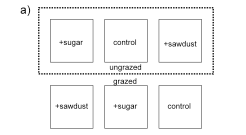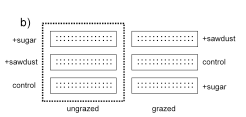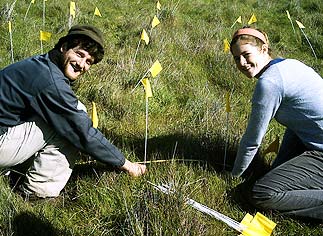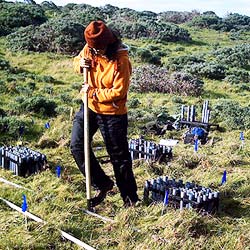Tipping the Balance Towards Native Grasses
 Across much of California, native grasslands have been replaced by non-native grassland communities. Understanding what processes encourage this expansion helps inform management approaches needed to conserve remaining coastal prairie habitats.
Across much of California, native grasslands have been replaced by non-native grassland communities. Understanding what processes encourage this expansion helps inform management approaches needed to conserve remaining coastal prairie habitats.
Changing Environments: Previous work at the UC Davis Bodega Marine Reserve (BMR) indicates that, in certain environments, the tables may be turned against non-native grasses. On small plots where grazing and soil nutrients were reduced, cover and biomass of native grasses increased, while cover and biomass of non-native grasses decreased.
Expanding Results for Management: Can these initial, promising results from a small-scale study at a single site be applied as a management tool to a variety of coastal prairie habitats?
With funding from the UC Integrated Pest Management program, we undertook a 3-year study (2006-2009) to answer this question.
What is Coastal Prairie?
Carpeting California’s fog-drenched coastal zone is a wonderfully diverse plant community no more than 2 feet high.
Plants of the coastal prairie include:
 Native grasses - Most of California’s native grasses are perennial, some living as long as a hundred years. Perennial grasses in coastal prairie remain green late into the year by harvesting summer fog and extending their roots deep into the soil. BMR prairie grasses include California oat grass (Danthonia californica), red fescue (Festuca rubra), Pacific wild rye (Elymus glaucus), and tufted hairgrass (Deschampsia cespitosa) California brome (Bromus carinatus), meadow barley (Hordeum brachyantherum), California reedgrass (Calamagrostis nutkaensis).
Native grasses - Most of California’s native grasses are perennial, some living as long as a hundred years. Perennial grasses in coastal prairie remain green late into the year by harvesting summer fog and extending their roots deep into the soil. BMR prairie grasses include California oat grass (Danthonia californica), red fescue (Festuca rubra), Pacific wild rye (Elymus glaucus), and tufted hairgrass (Deschampsia cespitosa) California brome (Bromus carinatus), meadow barley (Hordeum brachyantherum), California reedgrass (Calamagrostis nutkaensis).
 Native forbs - non-woody non-grasslike plants, such as wildflowers. BMR prairie forbs include Douglas iris (Iris douglasiana), blue-eyed grass (Sisyrinchium bellum), sea pink (Armeria maritima), goldfields (Lasthenia californica), sky lupine (Lupinus nanus), seaside daisy (Erigeron glaucus), clovers (Trifolium spp.) California poppy (Eschscholzia californica), and baby blue eyes (Nemophila menziesii).
Native forbs - non-woody non-grasslike plants, such as wildflowers. BMR prairie forbs include Douglas iris (Iris douglasiana), blue-eyed grass (Sisyrinchium bellum), sea pink (Armeria maritima), goldfields (Lasthenia californica), sky lupine (Lupinus nanus), seaside daisy (Erigeron glaucus), clovers (Trifolium spp.) California poppy (Eschscholzia californica), and baby blue eyes (Nemophila menziesii).
 Native sedges - superficially these plants resemble grasses but can be distinguished by stiff, angular (usually triangular) stems. BMR prairie sedges are in the genus Carex (e.g. Carex subbracteata).
Native sedges - superficially these plants resemble grasses but can be distinguished by stiff, angular (usually triangular) stems. BMR prairie sedges are in the genus Carex (e.g. Carex subbracteata).
 Non-native grasses, forbs and sedges -Roughly 1/3 of coastal prairie plant species at BMR are non-native, and several species, such as velvet grass (Holcus lanatus), are highly invasive.
Non-native grasses, forbs and sedges -Roughly 1/3 of coastal prairie plant species at BMR are non-native, and several species, such as velvet grass (Holcus lanatus), are highly invasive.
For more information about invasive plants in California, see the California Invasive Plant Council website.
Research Sites
We chose three coastal study sites with grasslands of similar species composition that were immediately adjacent to the ocean: Goat Rock-Sonoma Coast State Beach, Bodega Head-UC Davis Bodega Marine Reserve, Palomarin-Point Reyes National Seashore.
All sites included some areas with remnant native grasslands, heavy infestations of non-native grasses.
Research Methods
At each of the 3 study sites, we established two experiments: one in remnant native grasslands and the other in heavily invaded grasslands.
Experiment in Remnant Grasslands
Can native grasses recover if environmental conditions are altered in their favor (i.e., soil nutrients and grazing are reduced)?
 We set up 10 sets, or blocks, of plots at each of our 3 study sites. Each block contained 6 4 x 4 meter plots. Half of the plots were fenced to limit grazing by deer and rabbits. Both inside and outside the fence, one plot was treated with sugar to reduce soil nutrients by a proven method, one treated with sawdust to reduce nutrients by a method that might be more suitable for management, and one left untreated.
We set up 10 sets, or blocks, of plots at each of our 3 study sites. Each block contained 6 4 x 4 meter plots. Half of the plots were fenced to limit grazing by deer and rabbits. Both inside and outside the fence, one plot was treated with sugar to reduce soil nutrients by a proven method, one treated with sawdust to reduce nutrients by a method that might be more suitable for management, and one left untreated.
Experiment in Heavily Invaded Annual Grasslands
In heavily-invaded grasslands, can native grass seedlings survive and grow if environmental conditions are altered in their favor (i.e., soil nutrients and grazing and reduced)?
 We set up 8 blocks of plots at each of the 3 study sites. Each block contained 6 1 x 5.25 meter plots – big enough to allow us to plant 10-13 individuals of 3 native grass species in two parallel rows in each plot. The fencing and soil treatments were the same as in the experiment in remnant grasslands.
We set up 8 blocks of plots at each of the 3 study sites. Each block contained 6 1 x 5.25 meter plots – big enough to allow us to plant 10-13 individuals of 3 native grass species in two parallel rows in each plot. The fencing and soil treatments were the same as in the experiment in remnant grasslands.
Setting Up the Plots
We first marked the corners of each plot with flagging.


We installed fencing around half of the plots to keep deer and rabbits out. First we staked the edges of the plots with PVC pipe, and then attached chicken wire to the poles with zip ties. Over time, winds and salt spray corroded the chicken wire. We replaced old portions of the fence with plastic deer fencing which was lighter, cheaper, easier to install, and longer lasting. To prevent deer from jumping into the plots, we strung rope between PVC poles on either side of the plot.
Removing Nutrients From Soil
 Plants and soil microbes compete for soil nutrients. When sugar or other forms of carbon are added to soil, microbes grow rapidly, sequestering nutrients and making them unavailable to plants (e.g., Alpert and Maron 2000, Blumenthal et al. 2003).
Plants and soil microbes compete for soil nutrients. When sugar or other forms of carbon are added to soil, microbes grow rapidly, sequestering nutrients and making them unavailable to plants (e.g., Alpert and Maron 2000, Blumenthal et al. 2003).
While sugar readily reduces the availability of soil nutrients, results using sawdust have been more variable. But because sawdust is cheaper than sugar and may be a more affordable tool for managers, we decided to test the effects of sawdust as well as sugar additions in our experiment. We applied 0.5 kg m-2 of sugar and 1 kg m-2 sawdust on each plot.
To make sure that sugar and sawdust penetrated into the soil, we applied our treatments twice - once near the start of the rainy season (December) and once near the middle (February).
Growing and Planting 7,000 Grass Seedlings
 To investigate seedling survival in our Non-Native Grassland Experiment, we grew over 7,000 seedlings in the BMR greenhouse for 3-4 months. In the summer of 2007, we collected seeds from 3-4 native grass species growing at each of the 3 sites: Bromus carinatus, Danthonia californica, Deschampsia cespitosa, Elymus glaucus, Hordeum brachyantherum, and Nassella pulchra.
To investigate seedling survival in our Non-Native Grassland Experiment, we grew over 7,000 seedlings in the BMR greenhouse for 3-4 months. In the summer of 2007, we collected seeds from 3-4 native grass species growing at each of the 3 sites: Bromus carinatus, Danthonia californica, Deschampsia cespitosa, Elymus glaucus, Hordeum brachyantherum, and Nassella pulchra.
Seedlings were returned to their seed collection site in January and February of 2008.
In each non-native grassland plot, we made 2 parallel rows of holes using a dibble.
Seedlings were then planted randomly into the holes.
 Measuring Changes in Percent Cover
Measuring Changes in Percent Cover
How did our remnant natives do? In late May, we estimated cover for each plant species - both grasses and forbs - growing in our plots. For each species, we estimated % cover by classes (0-1%, 1-5%, 5-10%, 10-15%, etc.) in 2 permanent 50 x 50 cm subplots that we located in opposite corners of each plot.
Measuring Survival of Native Grass Seedlings
How did our seedlings do? In late May, we measured seedling survival by locating the seedling planting point and recording whether the seedling was alive, dead, buried, or not present.
Research Results
Our experiment is still in progress, but we have some preliminary results.
Interim Results in Remnant Grasslands
After two years of soil treatments at Bodega Marine Reserve and Peaked Hill,
- percent cover of native grasses increased
- percent cover of non-native grasses decreased
This effect was observed for both sugar and sawdust. We have not yet seen a significant effect of reduced grazing, but longer treatments may be needed. After one year of treatments at Palomarin, no changes in percent cover were detected among the treatments. Longer treatments may be needed to see effects.
Interim Results in Heavily Invaded Grasslands
About 73% of our native seedlings survived their first growing season at the 3 sites. No differences in survival have yet been detected among our treatments, either for nutrient or grazing reduction.
Longer treatments may be needed to detect differences, and we expect that the upcoming year may yield interesting results.
Coastal Prairie Materials for Managers and Educators
Websites
- California Native Grasslands Association
- California Native Plant Society (Grassland Initiative)
- California Invasive Plant Council
- California State Parks (Sonoma Coast State Park)
- Point Reyes National Seashore (prairies and grasslands)
- Elkhorn Slough Coastal Training Program
Books
- California Grasslands: Ecology and Management
- Terrestrial Vegetation of California (3rd edition)
- California's Fading Wildflowers: Lost Legacy and Biological Invasions
- California's Changing Landscapes: Diversity and Conservation of California Vegetation
- Introduction to Shore Wildflowers of California, Oregon, and Washington
Publications
Alpert, P. 2006. Sweet success: adding carbon to counter invasions by plants. Ecologically Based Invasive Plants Management 2(1):2-4.
Posters
- Emam, T. and P. Alpert. 2007. Early growth of introduced and native grasses on lupine-enriched soil. Poster presented at the public poster session of the Bodega Marine Lab Research Experiences for Undergraduates Program. PDF Available
- Karalius, T. and P. Alpert. 2007. Do Native American kitchen (midden) sites influence the cover of introduced species? Poster presented at the Massachusetts State Undergraduate Research Symposium. PDF Available
- Meyer, E. and P. Alpert. 2007. Restoring native grasslands via carbon addition and grazer exclusion: initial results of a multi-year study. PDF Available
- Lacey, M. and P. Alpert. 2008. Restoring native grasslands along the coast of northern California: interim results suggest sawdust will help. PDF Available
Presentations
- Alpert, P. October 2006. The advantages and disadvantages of having been introduced: European grasses on Bodega Head. Invited seminar, Department of Biology, University of Massachusetts - Boston.
- Alpert, P. November 2006. Sweet success: restoring coastal prairie on Bodega Head. Invited talk, Sonoma-Marin Coastal Prairie Workshop, Bodega Marine Laboratory.
- Alpert, P. January 2007. The advantages and disadvantages of being introduced: European grasses on Bodega Head. Invited talk, Annual Meeting of the California Weed Science Society, San Diego.
- Alpert, P. The advantages and disadvantages of being introduced: reversing invasion with sweets. Invited seminar, Department of Plant, Soil, and Insect Science, University of Massachusetts - Amherst.
- Alpert, P. The advantages and disadvantages of being introduced: fighting invasion by grasses with sweets. Invited seminar, Herbarium, Harvard University.
- Alpert, P. 2007. The advantages and disadvantages of being introduced: fighting invasion by grasses with sweets. Invited seminar, Harvard University.
- Luke, C. 2007. Field stations and marine laboratories: opportunities for students. Invited talk, Sonoma State University.
- Luke, C. 2007. Goings on at the Bodega Marine Reserve. UC Natural Reserve System Annual Meeting.
- Alpert, P. 2008. Managing the environment to control introduced, invasive species: restoring coastal prairie by sweetening soil. Invited talk, Point Reyes Bird Observatory.
